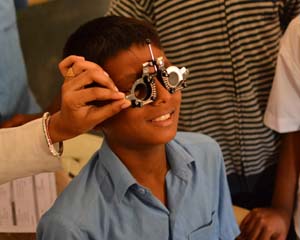 Children have especially high Zinc needs because they are growing rapidly. Fatigue, insufficient appetite, delayed development, poor attention spans, and increased susceptibility to infection are sometimes quite visible.
Children have especially high Zinc needs because they are growing rapidly. Fatigue, insufficient appetite, delayed development, poor attention spans, and increased susceptibility to infection are sometimes quite visible.
Even among adults, with long working hours and chronic stress, computer vision syndrome & digital eye strain are common issues. Headache, blurred vision, irritation, extra tearing, excessive blinking and even neck pain could also be symptoms of Zinc deficiency.
In the last decade, excessive use of computers, smartphones, laptops and video games have become common with children. Numerous studies have linked increased time spent by children indoors with greatly reduced outdoor activity time, as the key factor contributing to the rapid deterioration in children’s eyesight.
Studies indicate that intense blue light of electronic devices may cause damage to the retina of the eye. This heavy exposure in children could possibly lead to early onset macular degeneration which is a leading cause of blindness in future.
As children’s eyes are still developing, the blue light is able to penetrate efficiently & directly into the retina. Though blue wavelengths are crucial during daylight as they boost attention, reaction and mood, but they are disastrous at night as they interfere with circadian rhythms and disrupt sleep.
It is very sad to note that in India over 25% of childhood blindness is due to nutrient (primarily Vitamin-A) deficiency.
Many dietary supplements can improve vision, protect the retina and the eye lens, like Vitamin-E, Vitamin-C, and the trace minerals – Selenium & Zinc.
Zinc, the essential trace mineral, or ‘helper molecule’, is vital for eye health. Zinc is highly concentrated in the eye, mostly in the retina and choroid, the vascular tissue layer under the retina. It plays a crucial role in bringing vitamin-A from the liver to the retina in order to produce melanin, a protective pigment in the eyes.
At the cellular level, Zinc regulates the communication between retinal cells and controlling channels that allow ions to flow in and flow out of cells. The retinal pigment epithelium is a barrier that transports nutrients into the retina. It can only function when Zinc-dependent proteins are present.
Children have especially high Zinc needs because they are growing rapidly. Fatigue, insufficient appetite, delayed development, poor attention spans, and increased susceptibility to infection are sometimes quite visible.
Even among adults, with long working hours and chronic stress, computer vision syndrome & digital eye strain are common issues. Headache, blurred vision, irritation, extra tearing, excessive blinking and even neck pain could also be symptoms of Zinc deficiency.
In fact research has shown that over 285 million people in the world suffer from visual disorders, including visual impairment thus making crucial to focus on vision health.
Zinc has been shown to protect against age-related macular degeneration, night blindness, damage to optic nerve, impaired vision, poor night vision and cloudy cataracts. A person with Zinc deficiency in the body is also at risk for alopecia (loss of hair from eyebrows and eyelashes), mental sluggishness and increased susceptibility to infection.
Because Zinc is found in high concentrations in the eye, it is known to play a large part in eye health. Researchers have discovered that taking Zinc, along with various other antioxidants, could lower the risk of developing age-related macular degeneration by about 25%.
Studies published in the African Journal of Food, Agricultural, Nutrition and Development, have found that Zinc deficiency may be implicated in the high prevalence of cataract formation. The incidence of cataract development is more common in tropical countries due to the pronounced exposure to sunlight, and Zinc has the ability to protect the lens of the eye from oxidative damage. Cataract is in fact responsible for around 60% cases of visual impairment in India.
Zinc deficiency not only affects vision but has been ranked amongst the leading risk factors towards causing diseases worldwide. The underdeveloped nations regularly suffer from high mortality rates since Zinc deficiency causes childhood diarrhoea and pneumonia.
Experts recommend daily Zinc consumption of 8 milligrams (mg) for women and 11 mg for men. Good food sources of Zinc include nuts, seafood, spinach, mushroom, milk, yoghurt, eggs, cocoa, black-eyed peas, tofu and wheat germ.
Hindustan Zinc is India’s only and the world’s second largest integrated Zinc producer, proudly known as Zinc of India…
Article by- Pavan Kaushik, Head – Corporate Communication, Hindustan Zinc